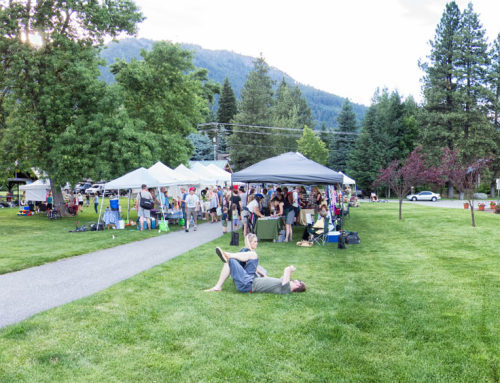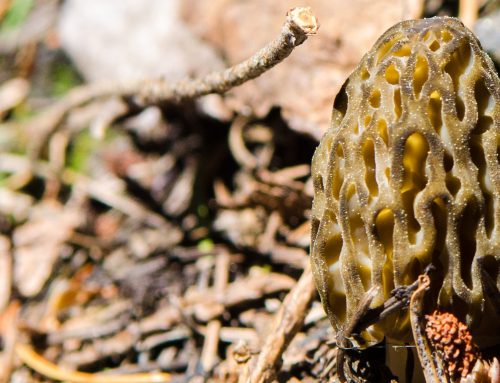It’s late-April in Leavenworth, WA and an unusually early start to spring following a dismal winter season with record low snow-pack. It’s also the spring following one of the worst wildfire seasons Washington State has ever endured with the burning of over 350,000 acres of forests, grasslands, rocky mountain slopes, farms, and rural areas, and even the small town of Pateros. Massive areas east of the Cascades in the Okanogan and Wenatchee National Forests were scorched to the ground leaving only blackened burnt stumps and fallen trees surrounded by an ashy forest floor.
As part of the cycle of nature, what is destroyed will be renewed. As early as March, green shoots started breaking the ground, followed by some of the first wildflowers. Melting snow and spring rains invigorated the soils, breathing life back into the landscape. And as part of this cycle, ingredients combine for the perfect recipe for a historically large harvest season of a highly sought after type of fungus known as the Morel Mushroom.

Following the wildfires that scorched areas throughout Washington State last year, there’s been a lot of anticipation about this year’s Morel mushroom harvest. Countless online articles speak of flocks of mushroom hunters heading to our hills with baskets and blades in hand to forage this exotic fungus that regularly sells from $10-$20 or more per pound due to the consistent problems with growing them in a controlled environment.
If you live in the Leavenworth area, consider yourself among the lucky that have the opportunity to find this mushroom so easily and so close to home. Those that are hunting commercially and wish to sell their fungus finds, will have to obtain a commercial permit, and while many will be coming from out of state for this harvest season, those of us that live close by are in a much better position to know when the conditions are right in order to capture some of nature’s treasures before they’re all gone. Fire Morels will begin popping through the pine needles around conifers and cottonwoods in areas that have burned the previous year following several rainy days with night time highs in the 40’s and day time highs in the 60’s. They tend to grow in scattered groupings sometimes with a pair joining at the base. If you find one, don’t take another step without closely inspecting the area around your feet for others. Natural Morels grow in similar conditions, but the ground doesn’t have to be charred.

When found, take care to harvest them correctly following the steps below which helps to spread the spores and gives the mushrooms a better chance of growing in that area again in the future.
- Clear the ground cover around the stem and use a sharp knife to cut the stem just above the mycelium base (the bulbous bottom of the stem).
- Move dirt and ground cover back over the mycelium base so it may continue to grow. If the base comes out of the ground, rebury it.
- Transport your finds in a loose knit cloth bag or woven basket to spread spores as you walk.
- Don’t harvest more than you plan to eat. Leave some for others to enjoy!
- Be careful not to harm growing plant life or disturb the wildlife.
- Respect Private Property and No Trespassing signage. A few tasty Morels are not worth fines and jail time, and land owners know to be on the lookout this time of year.
Here around Leavenworth, the Fire Morels have just started growing at our elevation and a little higher up. After checking the same general area for the past 5 weeks, waiting to see the first signs of this finicky fungus, just last weekend I found my first and enjoyed sharing them with friends.

Their life cycle lasts about 3 weeks from being too small to eat to the point of decaying, with their prime lasting about 8 – 10 days depending on environment and conditions (See a video of a Morel mushroom’s life cycle). There were lots of little ones still in the ground when I hunted last so I’ll be heading back for the next several weeks and expect to continue finding more.

A few words of caution before heading out to forage for fungus as food.
Never eat anything you forage unless you are 100% sure of what it is. Some varieties of Morel mushrooms are toxic and should not be consumed, especially in connection with alcohol. Consuming toxic mushrooms can cause serious intestinal discomfort or even death. Edible Morels are hollow all the way through from the stem to the tip of the cap (see the image below). The caps should be connected at the base of the stem, not at the tip of the cap. You shouldn’t be able to twist the cap around the stem at all. They appear in many shades from blond/pinkish, to black and brown, and are best eaten from when they’re an inch to several inches tall. Do not eat them if they feel mushy or soft; they should feel firm.
It’s recommended to cut them in half to inspect the inside (to make sure they’re hollow and that there aren’t any creepy crawlies inside), wash them under cold water and let them soak in cold salt water for a while to make sure any bugs come out. Then let them air dry on a paper towel and put them in a Tupperware in the refrigerator until you’re ready to cook them.

There are many ways to prepare Morels and one of the most common is simply sautéed with butter, oil, and garlic, salt and pepper to taste. They make a great addition to pasta, or can be enjoyed all on their own as a side dish. For a finger-food appetizer, batter them up, cover them in bread crumbs, and deep fry them in butter and oil. Yum….
This is just another reason why our little corner of the world is so amazing and special. Please enjoy it responsibly!




